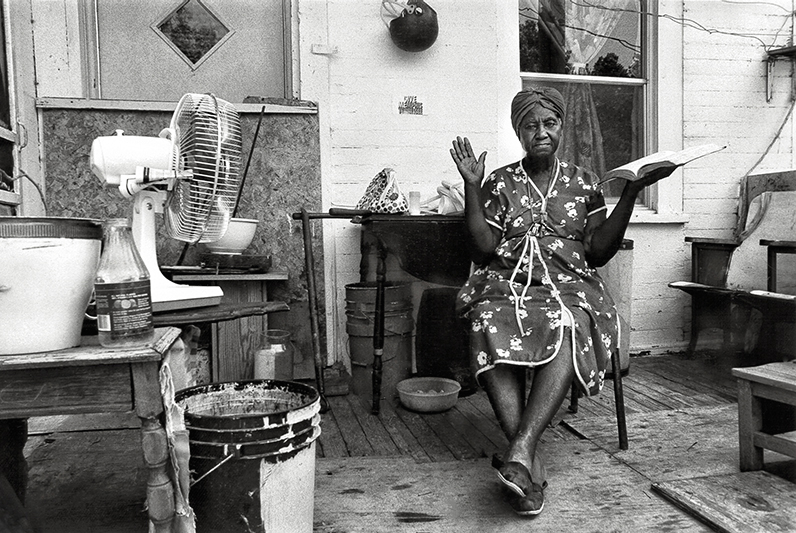
The most successful photographs usually have an important backstory. The making of this photo, The Believer, played a significant role in my evolution as a photographer.
In the documentary film Everybody Street, the late photographer Mary Ellen Mark said, “Often, your subject matter can show you what the picture is. I’m not a strong believer in heavy-duty concepts when I do portraits of people. I try to make iconic images. That’s my goal, to make images that stand on their own. Still pictures should be single, very powerful images.”
In our digital world, that’s a message seasoned photographers must constantly remember and new photographers must learn. Today, we shoot, edit, publish. We post here, there, and everywhere—Flickr, Instagram, Facebook, Twitter, Pinterest. Getting noticed has become a numbers game. We must constantly inject our work into the world, or perish, resulting in a glut of mediocre photos that we contribute to and sift through when viewing other people’s pictures. Perhaps we need to slow down, to wait.
In the early 1990s, I worked as a photographer for the Shelby County Government in Memphis, Tennessee. I was the only photographer, shooting everything from grip-and-grin photos to architectural and documentary shots for publications. On a typical day, I might take a photo of the mayor presenting a proclamation, then go to the county hospital to shoot in the newborn center, and later follow a visiting dignitary promoting a pet project.
One summer afternoon, my boss asked me to shadow a social worker, Kay, to take photos for a newsletter story about a heat intervention program that provided free portable fans. Heat was a serious health risk during summer months, because many impoverished Memphians didn’t have air conditioning, and some couldn’t afford to buy a fan to stay cool. During July and August, when temperatures would rise above 100° F (38° C), heat-related deaths would skyrocket.
That afternoon was a scorcher. When I arrived at Kay’s office, she said she knew exactly who I should photograph—a client of hers, an elderly woman who needed relief from the heat in the worst possible way. A lady I will always remember as The Believer.
When we arrived at the lady’s home, we found her sitting on the front porch. She wore a turban-like head covering, cheap canvas shoes, and the type of smock often worn by childcare workers or lunchroom attendants. A set of tarnished keys dangled from a cord around her neck, as she sat like the lady of the manor amongst an eclectic collection of stuff—an empty Gatorade bottle, a pair of antique wooden theater seats, an old football helmet, and an impressive collection of five-gallon buckets.
“Praise the Lord,” the woman said, as Kay walked to the front porch carrying the fan. “I’ve been praying and praying and I knew the good Lord would provide. I’m a believer!” Tears streamed down her face as she hugged Kay, and then me, and I found myself filled with a mix of emotions, from joy to sadness.
Stepping onto the front porch, I peered in the front door of her house and felt shocked by what I saw. She was a hoarder—the type that has to create paths from one room to another to navigate through floor-to-ceiling newspapers, furniture, books, and rubbish. She never opened the windows, fearing burglars, but most were inaccessible anyway, blocked by piles of junk. Once she shut the door, no fresh air could circulate in the house. I wondered how she had avoided dying from heatstroke. And if a fire had started inside the structure, she would have had virtually no way to escape.
I had the urge to pull out my camera and start shooting everything in sight, but my instincts told me to wait. I felt an immediate fondness for the lady. She had a strength of character that only poverty can create and it was clear she really did believe in something—some sort of deliverance, great or small, something that would rescue her from her plight. Hers was the type of belief I’d seen so often in Memphis’ poor neighborhoods, one that comforted her in the harsh reality of her condition.
As her tears dried, a smile filled her face. We sat and chatted for a while, Kay encouraging her to declutter her house, and I just listening, getting to know her. I imaged her as a pillar of the community and a fixture of the neighborhood, someone generations of children grew up knowing and loving. I envisioned her handing out homemade popsicles or calming a child who had fallen off of his bicycle.
When the time came for Kay and me to leave, I asked the lady if I could take a photo of her with her new fan. “Of course,” she replied, but then she asked if she could have her Bible in the photo. “Yes, ma’am,” I said. At first, she placed the Bible in her lap, her legs extended in a relaxed position. Click. That’s perfect for the news story, I thought. Then she opened the Bible, holding it in her left hand, while raising her right hand, as if testifying. Click! That one’s for me, I thought. I felt a wave of excitement, knowing the lady had just given me a portfolio piece, an image I would showcase and cherish for the rest of my life.
I rushed to the darkroom, knowing I had taken the type of iconic picture that had drawn me to photography in the first place. I spent hours in the darkroom perfecting the image—burning and dodging and setting up multiple trays of various developers to produce the best tonality. Years later, I would tweak and re-tweak the picture in Photoshop, always feeling the same affection for the lady and the image.
The Believer became one of a handful of iconic images I’ve taken in my career. In the end, one can only hope for a small collection of truly good photographs, even throughout a long career. Creating the picture taught me the value of my instincts; the ability to read a subject and situation and the knowledge that, when photographing people, respecting the dignity of a person and waiting for the right moment can produce the best results. And on rare occasions, your subject will give you a gift.
NOTE: Subscribe to my blog at the bottom of this page to receive announcements about future stories.


Photography is a method of believing, of contacting, of cherishing. What you have gotten on film is caught everlastingly… It recollects seemingly insignificant details, long after you have forgotten everything.
At the point when you photo individuals in shading, you photo their garments. In any case, when you photo individuals dressed in Black and white, you photo their spirits!